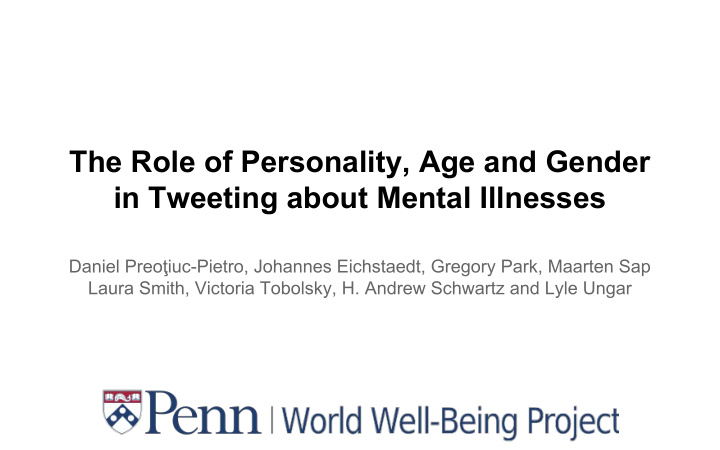



The Role of Personality, Age and Gender in Tweeting about Mental Illnesses Daniel Preoţiuc-Pietro, Johannes Eichstaedt, Gregory Park, Maarten Sap Laura Smith, Victoria Tobolsky, H. Andrew Schwartz and Lyle Ungar
Problem ● Mental illnesses are underdiagnosed
Problem ● Mental illnesses are underdiagnosed This Study: ● Explore the predictive power of demographic and personality based features. ● Find insights provided by each feature.
Data ● Twitter self-reports ‘I have been diagnosed with depression’ ● depression: 483 ● PTSD: 370 ● controls: 1104 ● each user has avg. 3400 messages (Coppersmith et. al, CLPsych 2014)
Study Setup mental Twitter language illness classification
Study Setup age, gender, mental Twitter language personality illness classification ?
Age, Gender ● Model from FB and Twitter data (Sap et. al, EMNLP 2014)
Age, Gender ● Model from FB and Twitter data (Sap et. al, EMNLP 2014)
Age, Gender
Personality ● Big 5 Personality Traits ○ openness ○ conscientiousness ○ extraversion ○ agreeableness ○ neuroticism ● Model from Facebook data (Park et. al 2014)
Personality ● Big 5 Personality Traits ○ openness ○ conscientiousness ○ extraversion ○ agreeableness ○ neuroticism ● Model from Facebook data (Park et. al 2014)
Personality ● mentally ill users: 1. high on neuroticism 2. more introverted 3. less agreeable
Personality ● mentally ill users: 1. high on neuroticism 2. more introverted 3. less agreeable ● controlling for age and gender
Personality
Age, Gender, Personality
Affect and Intensity ● Model trained on 3000 annotated FB posts and applied to all user posts (to be published) ● circumplex model similar to valence & arousal (ANEW)
Affect and Intensity ● Model trained on 3000 annotated FB posts and applied to all user posts (to be published) ● circumplex model similar to valence & arousal (ANEW)
Affect and Intensity ● mentally ill users are less aroused and less positive
LIWC ● standard psychologically inspired dictionaries ● 64 categories such as: parts-of-speech topical categories emotions ● standard baseline for open vocabulary approaches
LIWC
LIWC 7 features 64 features
Topics ● posteriors computed using Latent Dirichlet Allocation (LDA) ● underlying set of Facebook statues (same data as personality model) ● 2000 topics in total
Topics
Topics 7 features 64 features 2000 features
Topics: Depression Topics controlled for age and gender
Topics: PTSD Topics controlled for age and gender
Topics: PTSD, Depression, & Neuroticism
+ Dep, +++ PTSD ++ Dep, ++ PTSD +++ Dep, 0 PTSD
+ Dep, +++ PTSD ++ Dep, ++ PTSD +++ Dep, 0 PTSD
+ Dep, +++ PTSD ++ Dep, ++ PTSD +++ Dep, 0 PTSD
Topics
1-3 grams
1-3 grams 7 64 2k ~25k
1-3 grams: Depressed vs. Controls
1-3 grams: PTSD vs. Controls
1-3 grams: Depressed vs. PTSD Almost nothing left when controlling for age and gender
Other features… ● use metadata features # friends, #statuses ● use different word clusters Brown clustering, NPMI Spectral clustering, Word2Vec/GloVe embeddings ● linear ensemble of logistic regression classifiers Mental Illness detection at the World Well-Being Project for the CLPsych 2015 Shared Task D. Preotiuc-Pietro, M. Sap, H.A. Schwartz, L. Ungar
ROC Curve Depressed vs. Controls
ROC Curve PTSD vs. Controls
ROC Curve Depressed vs. PTSD
Take Home ● Control the analysis for age & gender
Take Home ● Control the analysis for age & gender ● Personality plays an important role in mental illnesses (depression auc: 7 features -> .78; 25k features-> .86)
Take Home ● Control the analysis for age & gender ● Personality plays an important role in mental illnesses (depression auc: 7 features -> .78; 25k features-> .86) ● Language use of depressed/PTSD reveals symptoms, emotions, and cognitive processes.
Thank you! wwbp.org lexhub.org
Recommend
More recommend